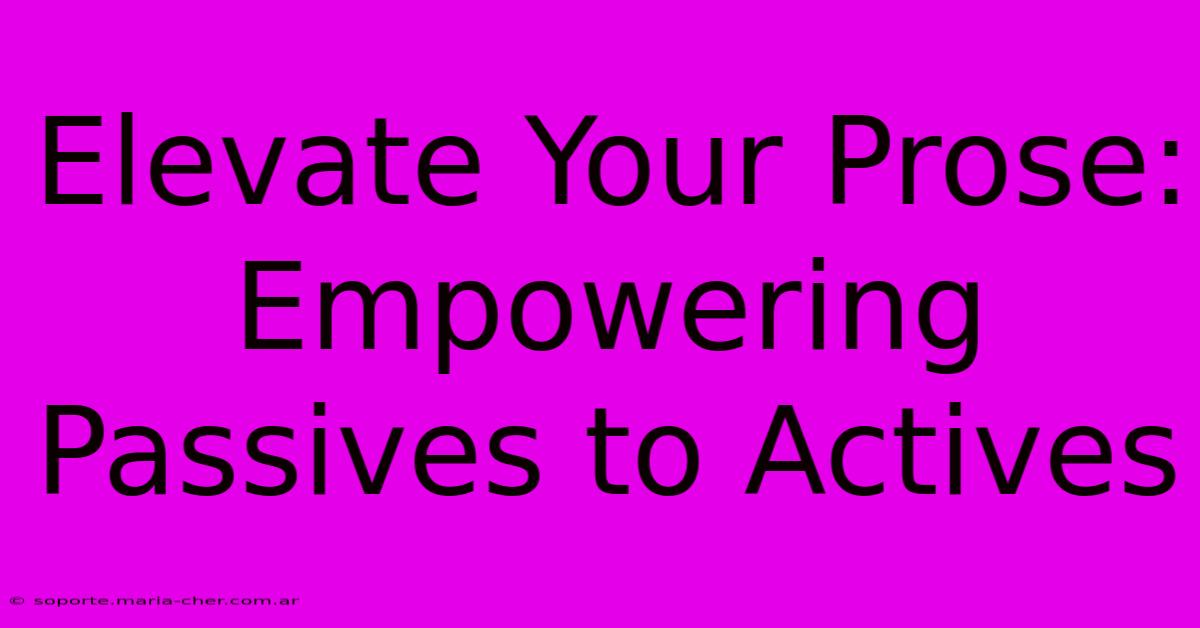Elevate Your Prose: Empowering Passives To Actives

Table of Contents
Elevate Your Prose: Empowering Passives to Actives
Strong writing is clear, concise, and impactful. One key element contributing to strong writing is the effective use of active and passive voice. While both have their place, overuse of the passive voice can lead to weak, convoluted sentences that muddy your message. This article will guide you on how to identify and transform passive sentences into their active counterparts, thereby elevating your prose and making your writing more engaging and powerful.
Understanding Active and Passive Voice
Before we dive into the transformation process, let's refresh our understanding of active and passive voice. The active voice emphasizes the subject performing the action. The structure is typically: Subject + Verb + Object. For example:
- Active: The dog chased the ball. (Dog = Subject, chased = Verb, ball = Object)
The passive voice, on the other hand, emphasizes the action being performed on the subject. The subject receives the action rather than performing it. The structure often involves a form of the verb "to be" plus the past participle: Object + Verb (to be) + Past Participle + by + Subject (often omitted). For example:
- Passive: The ball was chased by the dog. (Ball = Object, was chased = Verb (to be) + Past Participle, by the dog = Subject)
Why Choose Active Voice?
Active voice offers several compelling advantages:
- Clarity and Conciseness: Active sentences are generally shorter and more direct, making your writing easier to understand.
- Strength and Impact: Active voice gives your writing a sense of dynamism and energy. The subject's role is clear and upfront.
- Improved Readability: Readers process active sentences more quickly and efficiently. This leads to better engagement and comprehension.
- Enhanced Professionalism: In professional writing, active voice is often preferred for its clarity and authority.
Identifying Passive Voice Sentences
Recognizing passive sentences is the first step to transforming them. Look for these key indicators:
- Form of "to be" + Past Participle: Verbs like is, are, was, were, been, being, is being, has been, had been combined with a past participle (-ed or irregular form) often signal passive voice.
- Vague or Omitted Subject: The subject performing the action may be unclear or completely absent.
- Weak Verbs: The sentence might feel weak or indirect.
Example of a Passive Sentence: Mistakes were made. (Who made the mistakes? This is unclear.)
Transforming Passive to Active Voice: A Step-by-Step Guide
The conversion process typically involves these steps:
- Identify the subject: Find the word or phrase receiving the action. In the example above, "mistakes" is the object.
- Identify the verb: Determine the verb in its passive form. "Were made" is the passive verb phrase.
- Find the implied subject: If possible, identify the actor who performed the action. Sometimes, this requires adding information.
- Rewrite the sentence: Change the structure to Subject + Verb + Object.
Transforming the Example: Instead of "Mistakes were made," you could write: "We made mistakes" (Active Voice) or "The team made mistakes" (Active Voice, adding context).
Another Example: The report was submitted by John.
- Subject (Passive): report
- Verb (Passive): was submitted
- Implied Subject: John
- Active Sentence: John submitted the report.
When Passive Voice Is Acceptable
While active voice is generally preferred, there are situations where passive voice is appropriate:
- When the actor is unknown or unimportant: The window was broken. (We don't necessarily need to know who broke the window).
- When the action is more important than the actor: The patient was treated immediately. (Focus is on the treatment).
- To avoid blaming or accusing: A mistake was made in the calculations. (More diplomatic than saying "John made a mistake").
- To maintain objectivity in scientific writing: The experiment was conducted under controlled conditions.
Conclusion: Mastering the Active Voice for Powerful Prose
By understanding the nuances of active and passive voice and consistently employing active voice when appropriate, you can significantly enhance the clarity, impact, and overall effectiveness of your writing. Practice identifying and converting passive sentences to their active equivalents. With dedicated effort, you can elevate your prose to a new level of sophistication and precision. The result? Stronger, more compelling, and ultimately more impactful writing.

Thank you for visiting our website wich cover about Elevate Your Prose: Empowering Passives To Actives. We hope the information provided has been useful to you. Feel free to contact us if you have any questions or need further assistance. See you next time and dont miss to bookmark.
Featured Posts
-
Unlock The Key To Your Perfect Home Discover The Latest Perry Homes For Sale
Feb 04, 2025
-
3a765 The Color Code That Will Boost Your Sales And Conversions
Feb 04, 2025
-
Indulge In Sunday Serenity The Blanket That Calms The Mind And Soothes The Soul
Feb 04, 2025
-
Transform Your Celebrations With Custom Tablecloths Create Unforgettable Memories
Feb 04, 2025
-
The Blanket That Makes Sundays Feel Like A Warm Embrace Experience The Citizen Blanket Phenomenon
Feb 04, 2025
